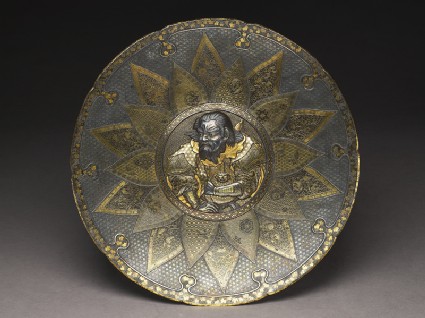Browse: 2201 objects
- Reference URL
Actions
Lobed dish with a Chinese warrior
-
Details
- Associated place
-
Asia › Japan › Honshū › Kyōto prefecture › Kyoto (Komai Company) (place of creation)
- Date
- c. 1885
- Artist/maker
-
Komai Company (c. 1841 - 1916) (manufacturer)
- Material and technique
- bronze, inlaid with gold and silver, and with shakudō, silver, and gold nunome decoration
- Dimensions
-
3.5 cm (height)
33.5 cm max. (diameter)
- Material index
-
processed material › metal › alloy › copper alloy › bronze,processed material › metal › gold,processed material › metal › alloy › copper alloy › shakudō
- Technique index
- Object type index
- No. of items
- 1
- Credit line
- Purchased with the assistance of the Story Fund, 1995.
- Accession no.
- EA1995.116
-
Further reading
Impey, Oliver, and Joyce Seaman, Japanese Decorative Arts of the Meiji Period 1868-1912, Ashmolean Handbooks (Oxford: Ashmolean Museum, 2005), no. 25 on p. 54, illus. pp. 54-55
Glossary
shakudō
-
shakudō
alloy of copper and gold, patinated to a dark blue-black colour
Location
Objects are sometimes moved to a different location. Our object location data is usually updated on a monthly basis. Contact the Jameel Study Centre if you are planning to visit the museum to see a particular object on display, or would like to arrange an appointment to see an object in our reserve collections.
Galleries
Publications online
-

Japanese Decorative Arts of the Meiji Period
Bronze, gold and silver lobbed dish with central relief panel of a bearded Chinese warrior in shakudō, silver and gold nunome-zōgan. The body of the dish with layers of radiating petal-shapes similarly inlaid in gold nunome-zōgan in various geometric patterns and scattered cherry blossoms and butterflies, the ground with silver stars, the border with vines. Signed on the reverse: Nihon koku Kyōto jū Komai sei.
The Komai Company was one of the specialist metalworking companies that descended from a sword-fitting company. Originally founded in 1841, the company did not start to make the inlaid works for which the company drew its reputation until the time of the founder’s grandson, Komai Otojirō I (1842-1917), at around the time when the wearing of swords was banned in Meiji Japan in 1876. The company’s name rarely appears in Exposition catalogues because of an agreement with the important commissioning company of Ikeda Seisuke, under whose name any Komai objects would be exhibited. His shop was first in Shinmonzen and later in Furumonzen, the haunts of foreign clients in Kyōto.
The company specialized in the making of bronze vases and dishes inlaid in zōgan technique in gold and silver. Dishes characteristically have a central motif with a large figure design, surrounded by pattern-making inlays, and frequently bordered by a vine pattern.
© 2013 University of Oxford - Ashmolean Museum









